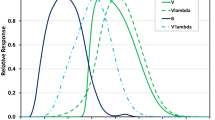Abstract
When assessing remote sensing data, nighttime light data have shortcomings that can be attributed to sensor limitations and the influence of the natural environment. Signal leakage errors in nighttime light data were identified in this study. A regression model was created to reduce signal leakage error by selecting sampling points in coastal area. Lighting variations in Edogawa between 2008 and 2013 were compared based on the Defense Meteorological Satellite Program’s nighttime light data. The lighting variation characteristics in Edogawa from 1992 to 2012 at 5-year intervals were also analyzed. The results show that the 2002 FIFA World Cup held in Japan led Edogawa’s light digital number values to peak in 2002. The annual Edogawa lighting changes from 2007 to 2013 were also explored. The 2008 global financial crisis led to the lowest compounded night light index and average digital number in Edogawa during these 7 years.






Similar content being viewed by others
References
Baugh, K., Elvidge, C. D., Ghosh, T., Ziskin, D. (2010). Development of a 2009 stable lights product using DMSP/OLS data. In Proceedings of the Asia Pacific advanced network 30th meeting (Vol. 30, pp. 114–130).
Baur, O., Kuhn, M., & Featherstone, W. E. (2009). GRACE-derived ice-mass variations over Greenland by accounting for leakage effects. Journal of Geophysical Research: Solid Earth, 114(B6), B06407.
Bezdecny, K. (2015). Imagineering uneven geographical development in Central Florida. Geographical Review, 105(3), 325–343.
Brannen, M. Y. (1992). Bwana Mickey: Constructing cultural consumption at Tokyo Disneyland. New Haven: Yale University Press.
Cahoon, D. R., Stocks, B. J., Levine, J. S., Cofer, W. R., & O’Neill, K. P. (1992). Seasonal distribution of African Savanna Fires. Nature, 359, 812–815.
Chand, T. R. K., & Badarinath, K. V. S. (2007). Quantification of trace gas emissions from shifting cultivation areas using remote sensing and ground-based measurements. Current Science, 92(7), 891–894.
Chen, J., Zhuo, L., Shi, P. J., & Toshiaki, I. (2003). The study on urbanization process in China based on DMSP/OLS data: Development of light index for urbanization level estimation. Journal of Remote Sensing, 7(3), 168–175.
Cho, K., Ito, R., Shimoda, H., & Sakata, T. (1999). Technical note and cover fishing fleet lights and sea surface temperature distribution observed by DMSP/OLS sensor. International Journal of Remote Sensing, 20(1), 3–9.
Croft, T. A. (1973). Burning waste gas in oil fields. Nature, 245, 375–376.
Croft, T. A. (1978). Nighttime images of the Earth from space. Scientific American, 239, 86–89.
Doll, C. N. H., Muller, J. P., & Morley, J. G. (2006). Mapping regional economic activity from night-time light satellite imagery. Ecological Economics, 57(1), 75–92.
Elvidge, C. D., Baugh, K. E., Kihn, E. A., Kroehl, H. W., & Davis, E. R. (1997). Mapping city lights with nighttime data from the DMSP operational linescan system. Photogrammetric Engineering and Remote Sensing, 63, 727–734.
Elvidge, C. D., Imhoff, M. L., Baugh, K. E., Hobson, V. R., Nelson, L., Safran, J., et al. (2001). Night-time lights of the world: 1994–1995. ISPRS Journal of Photogrammetry and Remote Sensing, 56(2), 81–99.
Elvidge, C. D., Ziskin, D., Baugh, K. E., Tuttle, B. T., Ghosh, T., Pack, D. W., et al. (2009). A fifteen year record of global natural gas flaring derived from satellite data. Energies, 2(3), 595–622.
Han, X. Z., Zhou, Y., Wang, S. X., Liu, R., & Yao, Y. (2012). GDP spatialization in China based on DMSP/OLS data and land use data. Remote Sensing Technology and Application, 27(3), 396–405.
He, C. Y., Shi, P. J., Li, J. G., Chen, J., Pan, Y. Z., Li, J., et al. (2006). Spatial restriction of urbanization in Chinese Mainland in 1990s using DMSP/OLS night light data and statistical data. Chinese Science Bulletin, 51(7), 856–861.
Letu, H., Hara, M., Yagi, H., Tana, G., & Nishio, F. (2009). Estimating the energy consumption with nighttime city light from the DMSP/OLS imagery. Joint Urban Remote Sensing Event, 1–3, 1364–1370.
Li, X., Li, D. R., Xu, H. M., & Wu, C. Q. (2017). Intercalibration between DMSP/OLS and VIIRS night-time light images to evaluate city light dynamics of Syria’s major human settlement during Syrian Civil War. International Journal of Remote Sensing, 38(21), 5934–5951.
Li, X. C., & Zhou, Y. Y. (2017). A stepwise calibration of global DMSP/OLS stable nighttime light data (1992–2013). Remote Sensing, 9(6), 637–643.
Operti, F. G., Oliveira, E. A., Carmona, H. A., Machado, J. C., & Andrade, J. S. (2018). The light pollution as a surrogate for urban population of the US cities. Physica A, 492, 1088–1096.
Small, C., Pozzi, F., & Elvidge, C. D. (2005). Spatial analysis of global urban extent from DMSP-OLS night lights. Remote Sensing of Environment, 96(3–4), 277–291.
Sutton, P., Roberts, D., Elvidge, C., & Baugh, K. (2010). Census from heaven: An estimate of the globe human population using night-time satellite imagery. International Journal of Remote Sensing, 22(16), 3061–3076.
Toyoda, Y. (2014). Recontextualizing Disney: Tokyo disney resort as a kingdom of dreams and magic. Social Science Japan Journal, 17, 207–226.
Tripathy, B. R., Sajjad, H., Elvidge, C. D., Ting, Y., Pandey, P. C., Rani, M., et al. (2018). Modeling of electric demand for sustainable energy and management in india using spatio-temporal DMSP-OLS nighttime data. Environmental Management, 61, 615–623.
Zhuo, L., Shi, P. J., Chen, J., & Toshiaki, I. (2003). Application of compound night light index derived from DMSP/OLS data to urbanization analysis in China in the 1990S. Acta Geographica Sinica, 58(6), 893–902.
Acknowledgements
This work is supported by National Key R&D Program of China (2017YFC0406004), NSFC (41271004).
Author information
Authors and Affiliations
Corresponding author
About this article
Cite this article
Cao, Y., Zhang, J., Yang, M. et al. Analysis of Lighting Changes in the Tourist City Edogawa Using Nighttime Light Data. J Indian Soc Remote Sens 46, 1617–1623 (2018). https://doi.org/10.1007/s12524-018-0815-x
Received:
Accepted:
Published:
Issue Date:
DOI: https://doi.org/10.1007/s12524-018-0815-x




